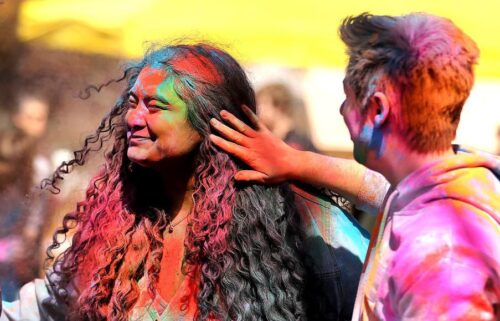Four generations of Burnham family members bustled about their Jamaica Plain home on a windy Friday morning. From 19-month-old Archer to 109-year-old Dorothy Burnham, the family prepared for their oldest family member’s birthday party.
Inside the home, a picture of a Mardi Gras Indian tribesman, wearing a vibrant, orange, feathered costume, hung on the back living room wall. Below the framed picture were carved head statues from Africa sitting on a side table. The Burnham household décor is a culmination of collected antiques and artwork produced by the Burnham family. Beside the statues, Burnham sat calmly, wearing a pale blue sweater.
Over the course of her life as an activist and academic, Burnham received many titles: freedom fighter, teacher, mentor, and scientist. But to her friends and family, Burnham is a doodler-extraordinaire, an eternal optimist, and a great-great grandma.
On Saturday, Burnham celebrated her 110th birthday at the Loring Greenough House in Jamaica Plain, making her the oldest person currently in Boston University’s New England Centenarian Study, a study focused on determining how people over 100 years old have escaped age-related diseases. She was surrounded by her friends and family who visited from across the country for the event.
The celebration at the Loring Greenough House hosted several dozen guests in various ornately decorated rooms. At the party, Burnham sat on a blue bench underneath gold balloons.
Burnham’s life devoted to civil rights, women’s rights, and science was kickstarted, she believes, during her time at Brooklyn College while studying biology.
Her initial goal after graduating with a bachelor’s degree was to attend medical school and become a doctor, but because of financial barriers, she was not able to achieve that dream. Instead, she turned her attention to activism.
She met her husband, Louis Burnham, in an organizing group called the Southern Youth Negro Congress, or SYNC. The couple organized sit-ins, freedom rides, and voter registration drives, before moving to Birmingham, Ala., where they lived for about eight years.
She and her husband eventually returned to Brooklyn, where Burnham worked at several hospital labs as a bacteriologist and later taught science at Hostos Community College and Empire State University.
Throughout her adult life, Burnham pushed for change in the medical field. She was a member of the Genes and Gender Collective, a group formed to discuss how the field of biology has contributed to scientific racism and sexism.
Burnham’s daughter Margaret Burnham attributed her mother’s desire to seek social change to her free college education, and more specifically the willingness of Brooklyn College professors to teach students about socialism and liberation.
One of Burnham’s professors, Jessie Campbell, encouraged her to join a protest, which set her on a path of activism for the rest of her life.
Burnham grew up in a home on Waverly Avenue in Brooklyn, with her parents and two sisters. Her parents, who immigrated to New York from Barbados, prioritized their children’s education, intentionally buying their house for its proximity to an elementary school.
“I think like most immigrants, they strongly believed that education was important for success,’’ Margaret Burnham said.
That strong desire to pursue education carried on through generations of the Burnham family. Burnham’s oldest sister, Elise Challenor Rollock, was among the first Black school principals in New York, and Burnham’s daughter is a distinguished professor of law at Northeastern University.
While a large portion of Burnham’s life was devoted to bettering her mind and the world around her, Burnham also paid attention to her health and body. She was careful about her diet, becoming an early adopter of a low-sugar diet and cutting out alcohol.
Now, however, Burnham enjoys cake and ice cream and has a bowl of strawberry ice cream every night before bed, her family said through laughter.
Burnham credits her long life to her friends and family.
“Only because I had a family that cares,’’ Burnham said of her 110 years of life.
Burnham’s youngest daughter, Linda Burnham, credited her long life to her resilience in the face of death.
“When her friend Ester [Jackson] passed at 105, that was the last of her generation,’’ Linda Burnham said. “But she’s been smart to make friendships in generations down from her.’’
Those friendships have helped Burnham form a strong community of support that has kept her going.
To feed her curiosity, she said, Burnham travels as much as she can. For many years, she took trips every summer to Africa.
Burnham also spends time on Martha’s Vineyard, where she and Margaret Burnham own summer homes. Her family refers to Burnham’s house in the Oak Bluffs Campground as her “gingerbread cottage.’’
Burnham also made trips to visit her daughter Linda in Oakland, Calif., every year until she was 105. That year, the COVID-19 pandemic made air travel difficult, so Burnham and her daughter spent three days on trains, crossing the country together. Now, Linda Burnham makes trips to visit her mom in Jamaica Plain.
As a mother, Burnham pushed her children both academically and holistically.
“She was gentle but firm,’’ Linda Burnham said. “She made sure we cultivated our minds and relationship to the world.’’
Burnham’s four children were encouraged to “take school seriously,’’ her daughters said, as well as play instruments. For her youngest child and only son, Charles Burnham, that encouragement led to a lifelong career as a violinist.
While Burnham sought immense social change over the course of a century, she believes that there is still work to be done.
“We’ve got a long way to go,’’ Burnham said.
However, Margaret Burnham said that her mom has done her time and “ran her race’’ as an activist.
“Her life was dedicated to others,’’ Margaret Burnham said.
Sarah Mesdjian can be reached at sarah.mesdjian@globe.com. Follow her on X @sarahs_journal.


